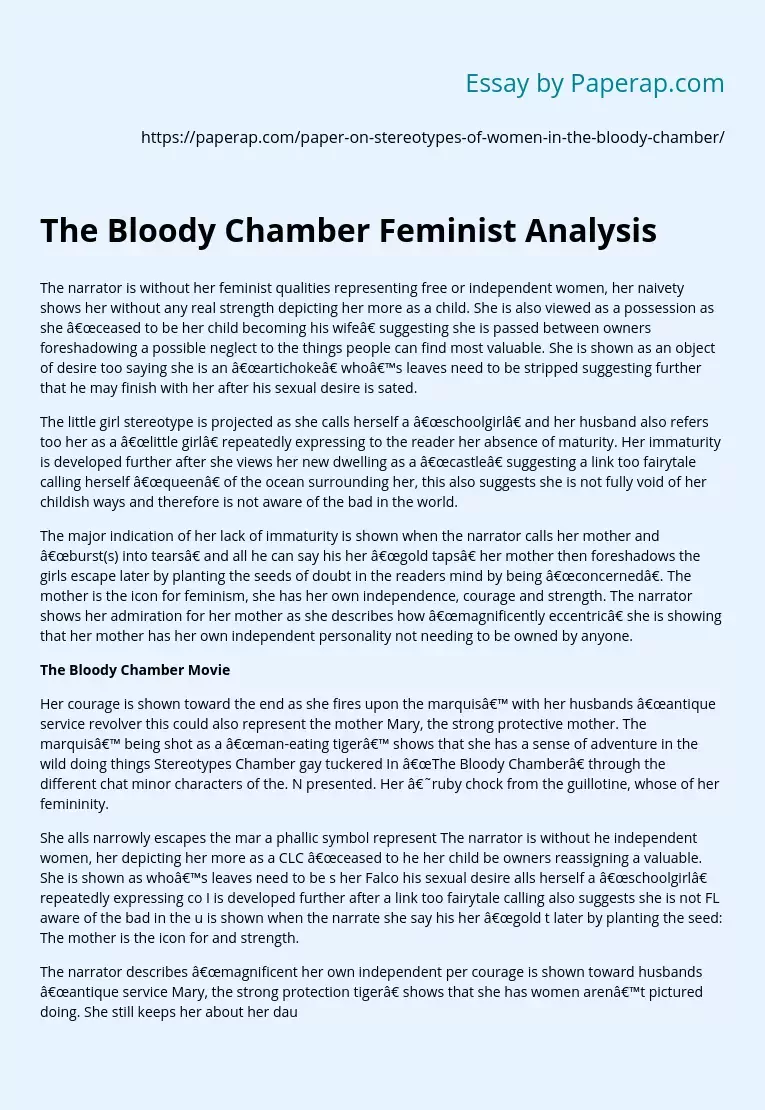The Bloody Chamber Feminist Analysis
The narrator is without her feminist qualities representing free or independent women, her naivety shows her without any real strength depicting her more as a child. She is also viewed as a possession as she “ceased to be her child becoming his wife” suggesting she is passed between owners foreshadowing possible neglect to the things people can find most valuable. She is shown as an object of desire too saying she is an “artichoke” whose leaves need to be stripped suggesting further that he may finish with her after his sexual desire is sated.
The little girl stereotype is projected as she calls herself a “schoolgirl” and her husband also refers to her as a “little girl” repeatedly expressing to the reader her absence of maturity. Her immaturity is developed further after she views her new dwelling as a “castle” suggesting a link to fairytale calling herself “queen” of the ocean surrounding her, this also suggests she is not fully void of her childish ways and therefore is not aware of the bad in the world.
The major indication of her lack of immaturity is shown when the narrator calls her mother and “burst(s) into tears” and all he can say is her “gold taps” her mother then foreshadows the girls escape later by planting the seeds of doubt in the reader’s mind by being “concerned”. The mother is the icon for feminism, she has her own independence, courage, and strength. The narrator shows her admiration for her mother as she describes how “magnificently eccentric” she is showing that her mother has her own independent personality not needing to be owned by anyone.
The Bloody Chamber Movie
Her courage is shown toward the end as she fires upon the marquis’ with her husband “antique service revolver this could also represent the mother Mary, the strong protective mother. The marquis’ being shot as a “man-eating tiger’ shows that she has a sense of adventure in the wild doing things Stereotypes Chamber gay tuckered In “The Bloody Chamber” through the different chat minor characters of the. N presented. Her ‘ruby chock from the guillotine, whose of her femininity.
She alls narrowly escapes the mar a phallic symbol represents The narrator is without he independent woman, her depicting her more as a CLC “ceased to he her child be owners reassigning a valuable. She is shown as who’s leaves need to be s her Falco his sexual desire alls herself a “schoolgirl” repeatedly expressing co I is developed further after a link too fairytale calling also suggests she is not FL aware of the bad in u is shown when the narrate she say his her “gold t later by planting the seed: The mother is the icon for and strength.
The narrator describes “magnificent her own independent per courage is shown toward husbands “antique service Mary, the strong protection tiger” shows that she has women aren’t pictured doing. She still keeps her about her daughter and protecting her but shows strong as well as feminine. Her masculinity is not t ere bravery in the face of evil toward the end of the masculine hero saving what seems to be a damsel constant contradictions of the stereotypes of whom the feminist and worldly view of choice even asking sure you love him? ” giving the daughter a choice SSL about her marriage.
Her romanticism is brought FCC love not money helping a reader to relate better The marquis’ embodies the temptations of women constantly as; an animal “leonine”, “vicuña”. This SYS woman going toward a strong male figure that has a personality. The re-libation into the fairytale word marquis allows the narrator to browse through TTL nettles ‘tailor-made”. He also gives the women implication as he tempts the narrator (eve) with the apple) in his house (the tree of knowledge). In conclusion, the depiction Of women covers sever society the more common three stereotypes been? and where.
The Bloody Chamber Feminist Analysis. (2019, Dec 05). Retrieved from https://paperap.com/paper-on-stereotypes-of-women-in-the-bloody-chamber/

